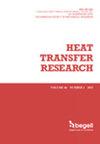Comparative experimental investigation on viscosity and stability of W/EG based non-Newtonian hybrid nanofluids for the heat transfer applications
IF 1.6
4区 工程技术
Q3 THERMODYNAMICS
引用次数: 0
Abstract
This study investigates the stability and rheological properties of water-ethylene glycol (W/EG) based non-Newtonian hybrid nanofluids incorporating SiC, Al2O3 and MWCNT nanoparticles. A two-step method was employed to prepare the hybrid nanofluids, using X-ray diffraction (XRD) and scanning electron microscopy (SEM) for the characterization of the nanoparticles. Stability assessment showed that Al2O3-MWCNT hybrid nanofluids are more optically stable than SiC-MWCNT as W/EG based Al2O3-MWCNT hybrid nanofluids took longer to sediment. Al2O3-MWCNT hybrid nanofluids exhibited superior stability in visual tests over a period of 19–21 days while SiC-MWCNT nanofluid took 12-14 days to sediment. Rheological analysis showed that increasing particle concentration increased the viscosity by 3.56 and 3.98 times for SiC-MWCNT and Al2O3-MWCNT hybrid nanofluids, respectively, compared to the base fluid. In contrast, increasing the temperature from 25 °C to 55 °C decreased the shear stress by 72.8% and 64.8% for SiC-MWCNT and Al2O3-MWCNT hybrid nanofluids respectively. Furthermore, the viscosity versus shear rate trends indicated a pseudoplastic or shear-thinning nature for both hybrid nanofluids with particle volume fraction above or equal to 0.1%.基于 W/EG 的非牛顿混合纳米流体在传热应用中的粘度和稳定性对比实验研究
本研究探讨了含有 SiC、Al2O3 和 MWCNT 纳米粒子的水-乙二醇(W/EG)基非牛顿混合纳米流体的稳定性和流变特性。采用两步法制备混合纳米流体,并使用 X 射线衍射 (XRD) 和扫描电子显微镜 (SEM) 对纳米粒子进行表征。稳定性评估表明,Al2O3-MWCNT 混合纳米流体比 SiC-MWCNT 具有更高的光学稳定性,因为基于 W/EG 的 Al2O3-MWCNT 混合纳米流体需要更长的时间才能沉淀。在 19-21 天的目视测试中,Al2O3-MWCNT 混合纳米流体表现出更高的稳定性,而 SiC-MWCNT 纳米流体需要 12-14 天才能沉淀。流变分析表明,与基础流体相比,增加颗粒浓度可使 SiC-MWCNT 和 Al2O3-MWCNT 混合纳米流体的粘度分别增加 3.56 倍和 3.98 倍。相比之下,将温度从 25 °C 提高到 55 °C 会使 SiC-MWCNT 和 Al2O3-MWCNT 混合纳米流体的剪切应力分别降低 72.8% 和 64.8%。此外,粘度与剪切速率的变化趋势表明,颗粒体积分数大于或等于 0.1% 时,两种混合纳米流体都具有假塑性或剪切稀化性质。
本文章由计算机程序翻译,如有差异,请以英文原文为准。
求助全文
约1分钟内获得全文
求助全文
来源期刊

Heat Transfer Research
工程技术-热力学
CiteScore
3.10
自引率
23.50%
发文量
102
审稿时长
13.2 months
期刊介绍:
Heat Transfer Research (ISSN1064-2285) presents archived theoretical, applied, and experimental papers selected globally. Selected papers from technical conference proceedings and academic laboratory reports are also published. Papers are selected and reviewed by a group of expert associate editors, guided by a distinguished advisory board, and represent the best of current work in the field. Heat Transfer Research is published under an exclusive license to Begell House, Inc., in full compliance with the International Copyright Convention. Subjects covered in Heat Transfer Research encompass the entire field of heat transfer and relevant areas of fluid dynamics, including conduction, convection and radiation, phase change phenomena including boiling and solidification, heat exchanger design and testing, heat transfer in nuclear reactors, mass transfer, geothermal heat recovery, multi-scale heat transfer, heat and mass transfer in alternative energy systems, and thermophysical properties of materials.
 求助内容:
求助内容: 应助结果提醒方式:
应助结果提醒方式:


